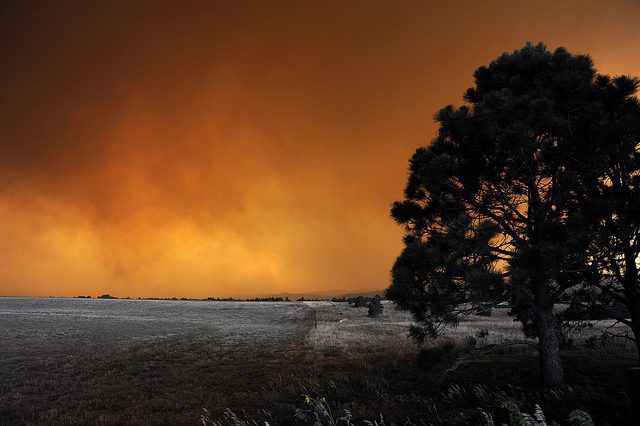
As fires continue to rage in Colorado, Montana, New Mexico, and other western states, the National Interagency Fire Center in Boise, Idaho yesterday raised the national fire preparedness level to “4” on a scale of 1 to 5. The heightened level indicates increased strain on federal resources battling the fires throughout the Rocky Mountain region and west.
President Obama visited the beleaguered city of Colorado Springs on Friday to offer support to local officials and residents as the Waldo Canyon fire officially claimed at least one life with more than 350 homes destroyed and 35,000 evacuees. Calmer winds and slightly cooler temperatures on Thursday finally allowed firefighters some headway on the fire, which is 15 percent contained as of Friday.
“I really appreciate the president coming here ,” said Colorado Springs mayor Steve Bach. “… if nothing more than just to reassure us that this has a focus at a national level, that there are people all over this country who are concerned for our citizens and those who have lost their homes. And I do plan to ask for cash.” Bach added.
In total, more than 1.6 million acres have burned across the west as firefighters and scientists wonder if current conditions signal a new normal for wildfire in region.
Wildfire in the new century
Wildfire is an essential component of a healthy forest ecosystem, but scientists say the High Park and Waldo Canyon fires in Colorado “deviate from historical norms in a number of important, and troubling, ways.”
“Historically, we can see evidence of much bigger fires than these,” says USGS ecologist Craig Allen. “But they weren’t behaving the same way. They weren’t killing all the trees.”
Western forests have been victim to nearly a century of management policy focused primarily on fire suppression that has allowed underbrush to accumulate and forests to thicken without the benefit of natural wildfire to thin out and burn up ground fuel. “In the absence of fire,” says Allen, “these forests have woodified. Now they can sustain a very different type of fire.” Instead of thinning and maintaining a healthy forest, these fires obliterate them.
“The saddest part of this is that these fires might actually change the face of the landscape,” said fire specialist Max Moritz, of the University of California, Berkeley’s College of Natural Resources. “These [ponderosa] stands might take a long time, or forever, to rebound.”
Entire ecosystems are thus transformed as new species take root. Where forests once stood, the hardest-hit areas in Colorado could become prairie and grassland, forever changing landscapes and ecosystems.
Adding to this is record heat and drought in the region combined with swaths of trees killed by the growing menace of mountain pine beetle infestation. The situation, says Craig Allen, is a consequence of two converging factors: land-use history and climate change. Years of forest mismanagement and altering the land to accomodate sheep and cattle grazing in the region have combined with climate change altering the nature of wildfire in American west.
President Obama talked on Friday of adapting policy to fit the new reality:
“Some lessons are being learned about how we can mitigate some of these fires in the future,” Obama said in Colorado Springs on Friday. “… Hopefully, out of this tragedy, some long-term planning occurs, and it may be that we can curb some of the damage that happens the next time.”

Main image credit: USDAgov, courtesy Flckr
Chart graphic courtesy National Interagency Fire Center


